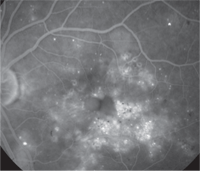Type 2 diabetes patients who use Actos (pioglitazone, Takeda Pharmaceuticals) or Avandia (rosiglitazone, GlaxoSmithKline) to control blood glucose levels are more likely to develop diabetic macular edema (DME), according to a study in the June 11 online edition of Archives of Internal Medicine.

The type 2 diabetes drugs Actos and Avandia may increase a patient’s risk of diabetic macular edema, as seen here.
Photo: Steven Ferrucci, O.D.
In several previous studies, these drugs––broadly classified as thiazolidinediones or glitazones––have been associated with an increased risk of cardiovascular disease, bone fracture and bladder cancer.
In this retrospective study, the researchers evaluated 103,368 patients with type 2 diabetes and no trace of DME at baseline. Of this study population, 3,227 patients had a history of thiazolidinedione use.
At one-year follow-up, the researchers determined that 41 patients on thiazolidinedione therapy developed DME, compared to 227 patients from the remainder of the entire study cohort.
“Patients who received a thiazolidinedione were at a two- to three-fold increased risk of developing macular edema,” says lead author Iskandar Idris, M.D., diabetes and endocrinology consultant at the Sherwood Forest Hospitals NHS Foundation Trust in Nottinghamshire, England. Because of this association, “More aggressive management of risk factors for macular edema should be implemented in patients who take a thiazolidinedione. In addition, routine screening for visual acuity should be performed during routine diabetes review, especially for patients who take thiazolidinediones,” he adds.
The researchers concluded that larger, more detailed meta-analyses of randomized, controlled trials still would be necessary to clearly establish a risk/benefit profile of thiazolidinedione use in patients who either have or are likely to develop DME.
Idris I, Warren G, Donnelly R. Association between thiazolidinedione treatment and risk of macular edema among patients with type 2 diabetes. Arch Intern Med. 2012 Jun 11:1-7. doi: 10.1001/archinternmed.2012.1938. [Epub ahead of print]

